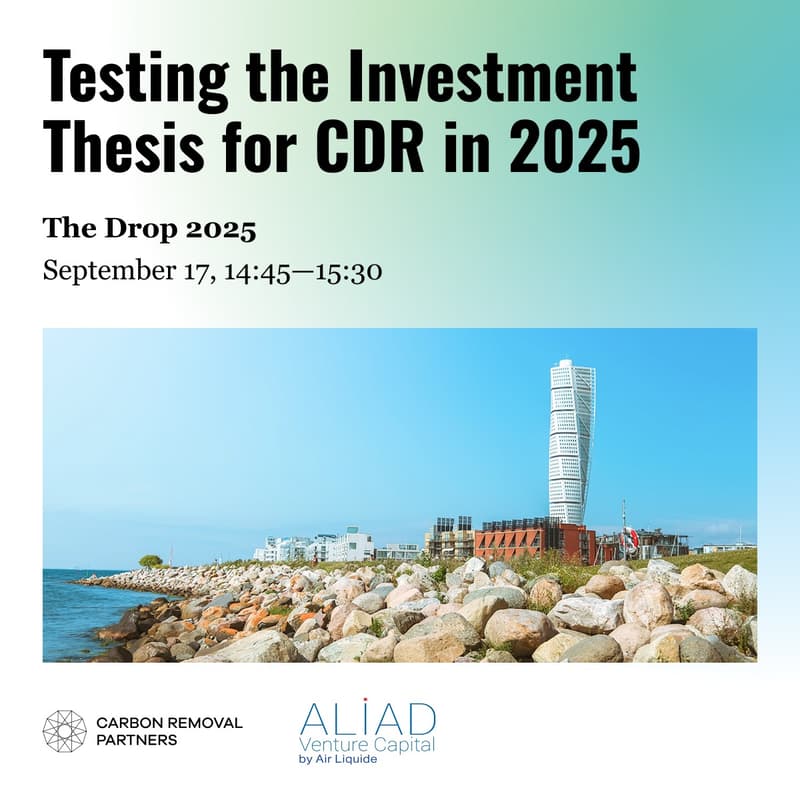

Testing the Investment Thesis for CDR in 2025
Ripple Hosts
Lisa Mangertseder
Carbon Removal Partners
Quentin Demarly
Air Liquide Ventures
TL;DR
Re-examine the investment thesis for Carbon Dioxide Removal (CDR) in 2025. What assumptions have held up, which have failed, and which new signals should investors and founders be using now. Should we still invest?
Topic overview
Carbon Dioxide Removal (CDR) has moved from niche concept to recognized pillar of climate action. Over the past years, billions in capital, new policy frameworks, and pioneering startups have shaped a fast-evolving industry. The initial investment wave of the early 2020s, fueled by optimistic projections, growth of VCM, policy support, and massive capital in ESG funds, is now meeting some hard realities of scaling, cost-reduction learning curves, and market volatility in geopolitical instability. In early 2025, the investment thesis underwent revision for many investors. Geopolitical turmoil, a VCM that's trending sideways, a deeper understanding of the technologies – investors are revisiting early assumptions, some are broadening their focus beyond VCM-dependent business models. At the same time, others are doubling down, pointing to market maturation, early signs of compliance markets taking shape, and a cascade of landmark purchase commitments that signal strengthening demand.
This session takes stock of where we are today: which elements of the CDR investment thesis continue to hold strong, what new drivers have emerged, and how the sector’s next chapter could look from an investor’s perspective.
What’s up for discussion?
a) The belief that VCM alone would provide sufficient revenue and price signals to scale the entire industry
b) The expectation of a smooth, solar-like cost reduction curve for all CDR technological pathways
a) Policy: moving beyond incentives to direct procurement. How are mechanisms like the US Inflation Reduction Act (45Q), direct government purchasing of CDR, and EU carbon removal frameworks creating more predictable revenue streams
b) Replacing credits with carbon-embedded products: business models where the value lies in a decarbonized product, not a credit (CO₂-negative concrete, SAF, or other e-fuels from DAC)
Verdict
Based on the revisited thesis, we will debate the ultimate question: As an investor in 2025, should you be actively deploying capital into CDR? If yes, where in the maturity cycle (early-stage, project finance, infrastructure) and in which pathway does the risk/reward profile look the most promising?
Dream outcome
To emerge from the 45-minute session with a clear, shared framework for evaluating CDR opportunities in 2025 and beyond. Attendees should leave with
An understanding of the new value driver for CDR that extends beyond speculative VCM credit sales
Whether a skeptic or a believer, attendees will have a more nuanced basis for their conviction, knowing which questions to ask and which red flags to look for in a pitch deck or an investment memo
An insight into the coming year in the industry, focusing on the convergence of policy, technology, and market demand that will separate potential winners from the rest
Who should attend?
Investors: VCs, private equity, family offices, and corporate venture arms who are either currently investing in CDR or actively considering the space.
CDR Founders and Executives: Startup leaders who need to understand the evolving mindset of investors to effectively fundraise and build resilient business models.
Policymakers and Regulators: Individuals shaping the compliance markets and incentive structures that are becoming crucial to the CDR investment case.